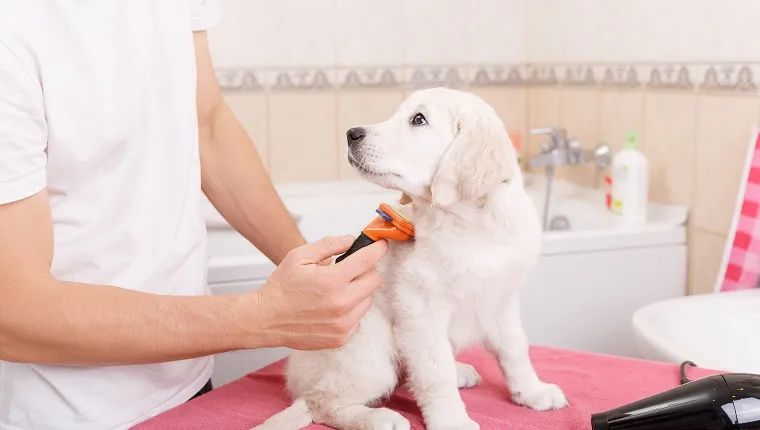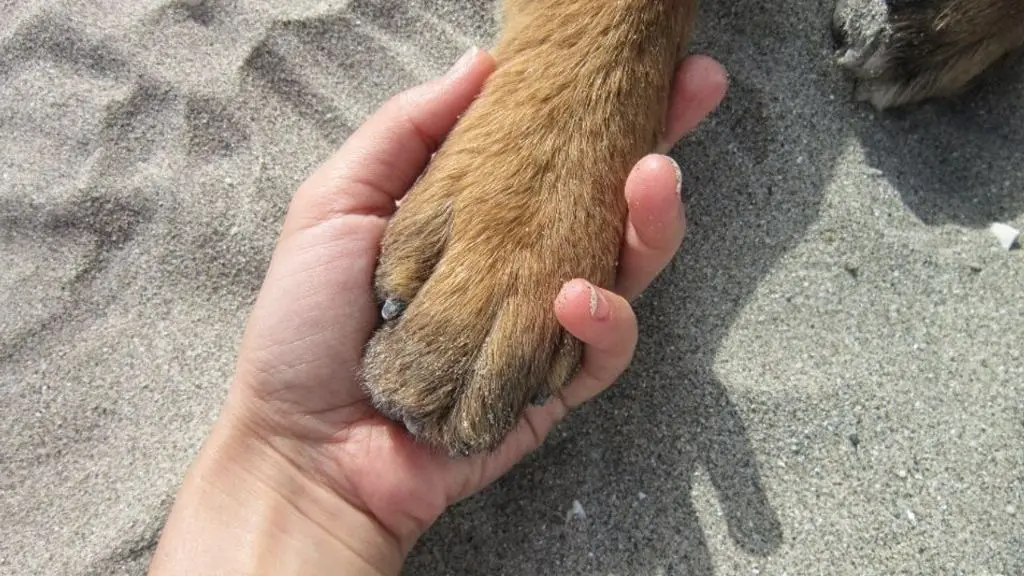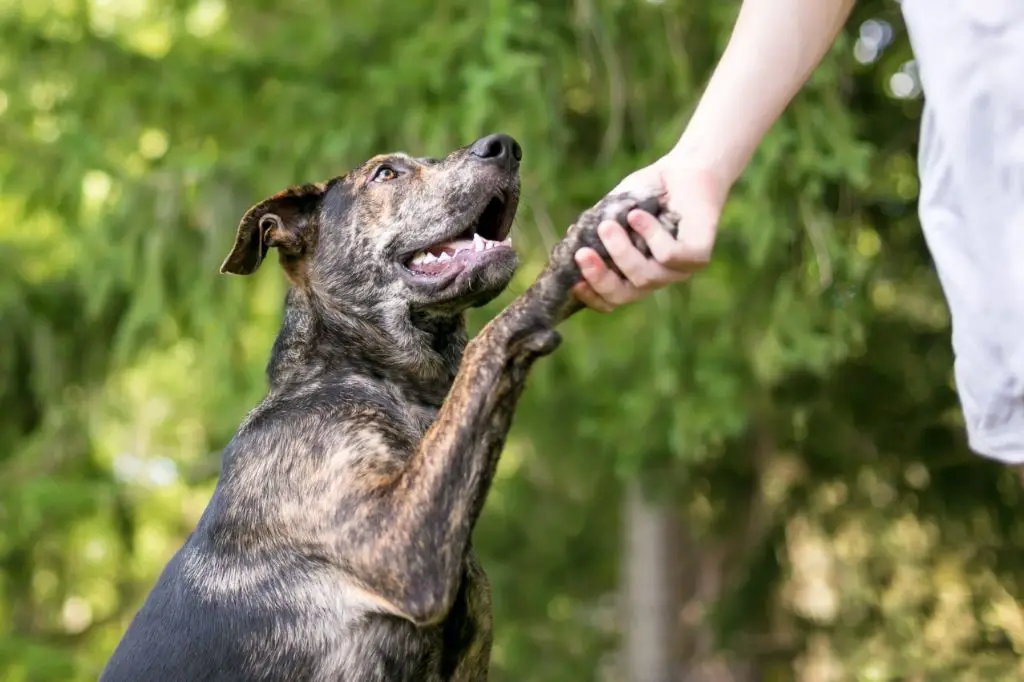Why It’s Important to Desensitize Your Dog’s Paws

Being able to handle your dog’s paws is incredibly important. Allowing gentle handling of paws helps your dog be more comfortable with routine grooming, nail trims, and vet examinations. If your dog becomes stressed or reactive when her paws are touched, it can make these necessary activities very difficult for both you and your pup.
Dogs with sensitivity around their paws may snap, growl, or jerk their paw away when it’s touched unexpectedly. They want to avoid an unpleasant or uncomfortable sensation. This reaction can progress to more aggressive behavior over time if the sensitivity isn’t addressed.
By gradually desensitizing your dog and making paw handling a positive experience associated with rewards, you can help her become more comfortable and tolerant. She’ll learn that having her paws touched does not need to be scary or painful.
Desensitization allows important activities like trimming nails to become stress-free experiences you can do at home. It also means your dog can relax and comply during veterinary exams instead of needing restraint or sedation.
Making paw handling a breeze helps ensure your dog stays happy and healthy.
How to Know If Your Dog Needs Paw Desensitization
Many dogs dislike having their paws touched. But if your dog reacts strongly or shows signs of fear or aggression when her paws are handled, it’s a good idea to work on desensitization. Here are some signs your dog would benefit from paw handling training:
- Pulls paw away or tucks paws under body when you reach for them
- Growls, snaps, or bites when paws are touched
- Shies away or startles when paws are approached or handled
- Appears anxious, stressed, or fearful during paw handling
- Avoids walking on certain surfaces like grass, tile, or wood floors
- Dislikes nail trims or vet exams involving paws

If your dog exhibits reactions like these, it’s a good idea to gradually get them comfortable with paw handling through desensitization techniques. The earlier you can start, the better!
Start Slow With Treats and Praise
When starting to desensitize your dog to having their paws handled, it’s important to take things very slowly and make the experience positive. Start by giving your dog treats to get them feeling happy and distracted. While they are focused on the treats, briefly touch their paw and then immediately reward them with praise, more treats, and affection.
Keep sessions very short, just a few seconds at first. The second you touch their paw, mark the behavior with a “yes!” or click of a clicker, give a treat, and take your hand away. As your dog gets comfortable with this, you can touch their paw for slightly longer before marking and rewarding.
The key is to pair any paw touching with something your dog finds rewarding. Over time, they will come to associate having their paws handled with good things happening. By keeping sessions short and providing lots of rewards, you can gradually desensitize your dog in a positive way.
Handle Paws During Low-Stress Times
One of the best times to handle your dog’s paws is when they are relaxed or even sleeping. Your dog is less likely to be bothered by having their paws touched when they are already in a calm state of mind.
Try briefly touching your dog’s paws while they are napping or resting. Keep it very quick and light at first – just a brief touch and release. You don’t want to startle them. Over time, as your dog adjusts, you can touch their paws for slightly longer periods while they are relaxed.
Getting your dog comfortable with having their paws handled when they are already relaxed and calm will help set the foundation for them tolerating paw handling at other times as well.

Work at your dog’s pace and keep sessions short. If they seem bothered or tense up, back off and try again later when they are settled once more. With time and positive consistency, your dog will learn to accept light paw handling as part of their resting routine.
Use Daily Activities as Training Opportunities
Take advantage of your normal daily routine with your dog as opportunities to work on paw desensitization. When you go to put on your dog’s leash or collar, give them a treat as you gently touch their paws. You can also touch their paws briefly while brushing or petting them. The key is to associate having their paws handled with positive experiences like treats, praise, play and affection.
Routines like walks, feeding time and grooming that your dog is already comfortable with are great times to incorporate brief, gentle touches to their paws. Go slowly and keep the sessions short. If your dog seems uneasy, go back to an earlier step in the process. The goal is to help them make a positive connection between having their paws touched and activities they enjoy.
Don’t Rush the Process
It’s important not to rush the paw desensitization process. Go at your dog’s pace and don’t force interactions or try to speed things up. If your dog seems uneasy or pulls away when you touch their paws, slow down and take a few steps back. Give them more time to get comfortable before trying to handle their paws again.
Pushing too fast can cause your dog more anxiety and stress around having their paws touched. This will undermine the desensitization training and make the process take longer in the end. Be patient and let your dog set the pace. They will become more comfortable with paw handling through calm, positive reinforcement over time.
Make sessions brief, ending on a good note. Gradually extend handling little by little as your dog relaxes into it. But don’t move faster than they are ready for. Consistency is important, but forcing things can do more harm than good. Go slowly, build up your dog’s confidence, and let them overcome their paw sensitivity at their own natural pace.
Keep Sessions Brief
When you first start paw desensitization training, keep each handling session very short. Begin with just seconds of touching or holding your dog’s paws, then slowly work up to longer durations over multiple sessions. Going too long too fast can overwhelm your dog. Start with 5-10 seconds of handling, then over days and weeks, gradually work up to 30 seconds, then a minute, then 2-3 minutes.
Watch your dog’s body language closely during sessions. If they show any signs of stress, discomfort or resistance, end the session immediately. Keeping handling brief prevents pushing your dog too far too fast. With shorter, more frequent sessions, you can slowly acclimate your dog to having their paws touched in a way that is positive rather than scary.
Be patient and don’t expect too much too soon. Brief sessions will pay off in the long run as your dog becomes more and more comfortable. Over time, you can handle paws for longer periods and make it part of your daily routine like brushing or petting.
Watch for Signs of Stress

As you work on paw desensitization, pay close attention to your dog’s body language. Signs of stress may indicate you’re moving too fast and need to take a step back. Common signs of stress to watch for include:
- Yawning – Excessive yawning is a calming signal dogs use when under stress.
- Lip licking – Dogs may lick their lips when anxious or uncertain.
- Panting – Heavy or abnormal panting can signal stress or discomfort.
- Restlessness – Fidgeting, shaking, or pacing shows your dog is unsettled.
If you notice these or other stress signals, end the session on a positive note with a treat and praise. Then provide a break before attempting to handle your dog’s paws again. Going too fast with desensitization can backfire, so it’s important to ease into it based on your individual dog’s tolerance levels.
End on a Positive Note
If your dog seems nervous or uneasy during paw handling, don’t force it. Stop touching their paws and end the session on a positive note with praise, petting, or a treat. You don’t want them to associate paw touching with fear or anxiety.
It’s better to stop and try again later than to push your dog past their comfort zone. Rushing the desensitization process can actually make dogs more sensitive over time.
Pay attention to your dog’s body language. If they start whining, shaking, hiding their paws, or showing other signs of distress, take a break immediately. End with something they enjoy, and be patient as you work at your dog’s pace.
Be Patient and Consistent
Desensitization takes time and routine. Some dogs may show improvement in just a few weeks, while others may take months. The most important thing is to stick with the training and have realistic expectations. Don’t expect immediate results or try to rush the process.
Aim to handle your dog’s paws multiple times per day during calm moments like petting or brushing. Make it part of your regular care routine. With enough repetition and positive reinforcement over an extended period, your dog will gradually get more comfortable having their paws touched.
Remain patient, even if your dog seems sensitive at first. If you get frustrated or try to force interactions, it will undermine the training. Stay relaxed and keep sessions brief. As long as you are making gradual progress, be consistent with the desensitization techniques every day.
Eventually, your dog will learn that having their paws handled leads to rewards, not fear. But you need to put in the time and be patient. With a routine of calm, structured training, your dog’s paw sensitivity can improve dramatically over time.